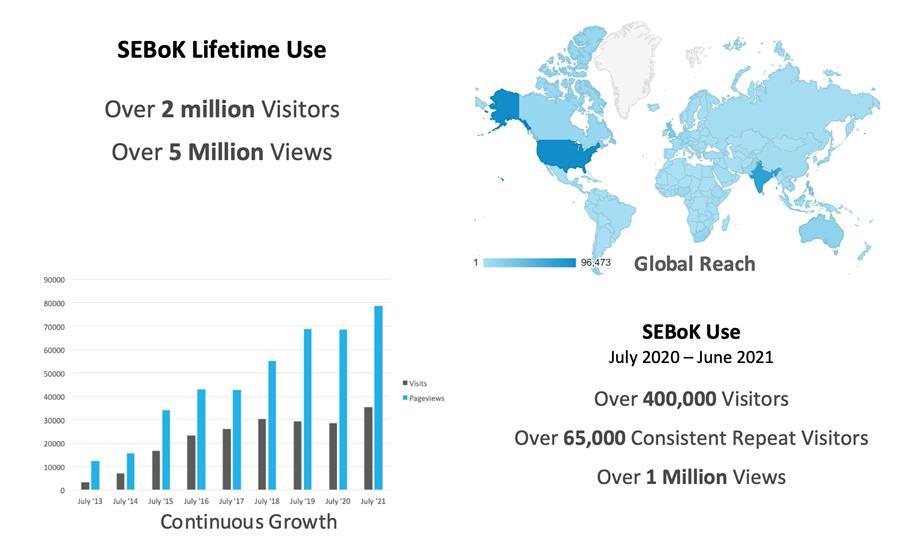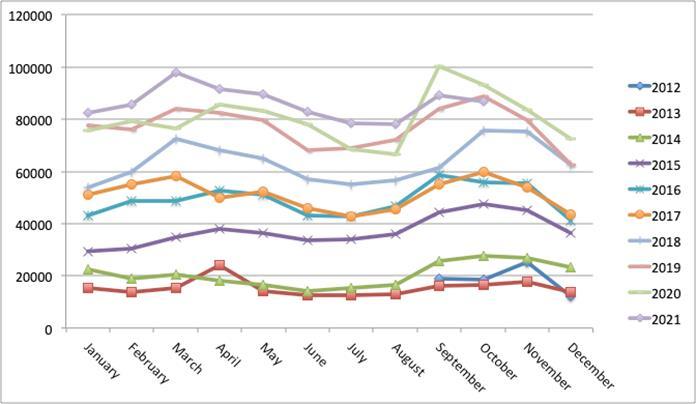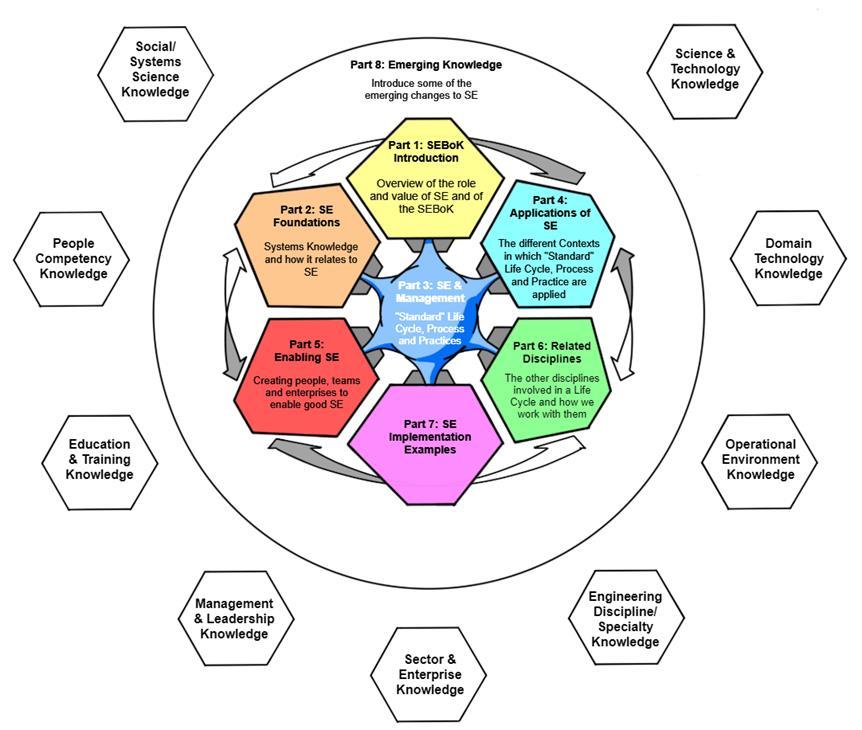
13 minute read
Update on the Systems Engineering Body of Knowledge
by Nicole Hutchinson, PhD. Stevens Institute of Technology
Update on the Systems Engineering Body of Knowledge Email: nicole.hutchison@stevens.edu
Copyright © 2021 By Nicole Hutchinsonby Nicole Hutchinson. Authored for PPI SyEN. All rights reserved. Authored for PPI SyEN
Abstract
In 2012, the Guide to the Systems Engineering Body of Knowledge (SEBoK) set a new precedent –delivering a curated, authoritative professional body of knowledge in a wiki format. Until that time professional bodies of knowledge had been created as documents, or in some cases, those documents had been converted to static websites. The SEBoK team created a mechanism for maintaining quality while allowing for more rapid update and turnover. Since 2012, the SEBoK model has been used by several bodies of knowledge. This article provides perspective on the evolution of the SEBoK, answers some common questions around the SEBoK, and discusses future evolution.
Introduction and Background
Starting in 2009, the Body of Knowledge and Curriculum to Advance Systems Engineering (BKCASE™) project was launched by the US Department of Defense to create a body of knowledge for systems engineering and a reference curriculum for systems engineering graduate education. The creation of the Guide to the Systems Engineering Body of Knowledge (SEBoK) and the Graduate Reference Curriculum for Systems Engineering (GRCSE™) has been detailed in many publications (e.g. Adcock 2016; Miller et al. 2013; Hutchison et al. 2012). A summary is that a global team of over 80 individuals across government, industry, and academia, supported by hundreds of reviewers around the world, created the SEBoK and GRCSE over three years, with the initial offerings (called version 1.0 for both) released in 2012.
The SEBoK set a new technical precedent – delivering a curated, authoritative professional body of knowledge in a wiki format. To that point, professional bodies of knowledge had been created as documents, or in some cases, those documents had been converted to static websites. The SEBoK team created a mechanism for maintaining quality while allowing for more rapid update and turn over. The SEBoK is now on version 2.5, the seventeenth major release since 2012, while becoming the most-used reference for systems engineering in the world. The SEBoK has seen over 2 million unique users and continues to see growth over time. This rapid evolution has been coupled with a focus on quality, with every update to the SEBoK meeting several key criteria: • Philosophy – the SEBoK is a guide to the body of knowledge, not a compendium. This means that authors and editors strive to add new references and summarize as appropriate, not to re-create existing materials. • State of Practice and the Art – the SEBoK reflects the discipline of systems engineering as it stands, including both current practices and approaches as well as advanced techniques that are still maturing. • Descriptive – As part of accurately representing the practice, the SEBoK seeks to summarize and describe the literature available around the world, not just a single point of view. This means that if the systems community disagrees about a topic, both perspectives are reflected in the SEBoK, with discussion around situations where one perspective or another might more readily apply.
• Available – The SEBoK only includes resources that users can reasonably access. This does not mean “free” – users might have to purchase textbooks and journals, for example – but it does mean that the materials are accessible. For example, proprietary materials that are behind an organization’s firewall or anything that would be considered sensitive or classified in a government context is not included.
SEBoK Use
The SEBoK is the number one resource for systems engineering information in the world and basic statics about the SEBoK are found in Figure 1. The SEBoK sees an average of 30,000 users per month and is consistently referenced in government, academia, and industry.

Figure 1. Overview of SEBoK Use (lifetime and academic calendar year 2021)
As figure 1 illustrates, the heaviest use of the SEBoK comes from the United States. This has been the case since its launch in 2012. However, the patterns of geographical use over time have also shown where systems engineering as a discipline may be surging and growing. For example, India, the country with the second heaviest SEBoK use so far in 2021, was not in the top 10 when the SEBoK launched in 2012. The UK and Australia were the second- and third-heaviest users of the SEBoK, respectively, early on and though their use has increased over time, it has not grown as rapidly as use in India.
Additional analysis of SEBoK use shows a consistent growth in use over time (shown in pageviews in Figure 2). It also gives indications of academic use of the SEBoK, as the Dec-Jan and June-July time frames tend to see dips in use. Anecdotally, the SEBoK editors have received indications from faculty across a variety of universities stating that they use the SEBoK in their courses, some to supplement their texts and some in place of traditional textbooks. But Figure 2 also illustrates that academic use of the SEBoK is only part of the user community. Estimations based on the data from SEBoK use indicate the SEBoK gets 20-30,000 pageviews a month from academic sources, meaning that currently an average of 50,000 pageviews come from government and industry each month.

Figure 2. Overview of SEBoK use (in pageviews) by month since 2012.
SEBoK Structure
The SEBoK began with seven “Parts” or major themes. The current version of the SEBoK includes eight distinct parts, as illustrated in Figure 3. The parts represent the logical architecture of the SEBoK, or the authors’ and editors’ mental models of how systems engineering information is organized and related. These parts have remained largely stable since release in 2012, though within the parts the knowledge areas have changed to reflect updates in the discipline. Part 8 was added in 2020 to reflect the most cutting-edge knowledge in systems engineering. Part 1 is an introduction to the SEBoK and to the discipline of systems engineering itself. It sets expectations about what users can expect to find, what is considered out of scope, and thoughts on users and uses. This sets the context of the SEBoK and provides foundational insights into the discipline. Part 2, “Systems Engineering Foundations”, provides an overview of the systems principles that underlie the discipline of systems engineering. It helps define the “what” of systems engineering –what are systems, what does it mean to take a systems approach to a challenge or problem, and what is systems science. Part 2 also introduces the concepts of system models, what they are, and why they are beneficial.
Part 3, “Systems Engineering and Management” builds upon these foundations to define the fundamentals of the discipline of systems engineering itself. It includes the “typical” systems engineering lifecycle knowledge expected around process – for example the types of processes defined in ISO 15288 or the INCOSE Systems Engineering Handbook – as well as fundamentals of managing systems engineering work and processes orthogonal to the lifecycle such as configuration and risk management. It descriptively answers the question, “What is systems engineering?”, providing pointers to a variety of methods, processes, and tools.

Figure 3. SEBoK Organization
Part 4, “Applications of Systems Engineering”, describes what changes about systems engineering based on the context. For example, what does a practitioner need to do or think about differently if working on a product system versus an enterprise system? What are special considerations around systems of systems? And, finally, Part 4 includes an example of specific things systems engineers need to know when working in one particular domain: healthcare. This first example was added in 2015 and the goal is to add more of these domain-focused examples over time. Part 5, “Enabling Systems Engineering” goes outside of the realm of process, methods, and tools to talk about the fundamental competencies required of systems engineers and the organizational considerations to enable systems engineering capabilities. Part 6, “Related Disciplines” touches on a number of disciplines that are relevant to systems engineering and answers the questions, “What does a systems engineer need to know about this discipline?” It includes standard disciplines like software engineering and industrial engineering as well disciplines that focus around system attributes like safety, security, and reliability. Part 7, “Implementation Examples”, is perhaps one of the more unique among bodies of knowledge. These are, essentially, case studies of real-world systems – some successful, some not – that illustrate the benefits of and pitfalls of systems engineering in a real-world context. These examples link back to the knowledge contained elsewhere in the SEBoK, so that if an individual finds a challenge or situation similar to their own in an example, they can follow the wiki back to additional sources. Part 8, “Emerging Knowledge” was added in 2020 and represents the desire to make it even easier to incorporate rapidly evolving knowledge into the SEBoK. It includes topics such as what is the
relationship between systems engineering and artificial intelligence and how is “digital engineering” related to systems engineering and specifically model-base systems engineering. It also includes recent dissertations in systems engineering, again providing insights into advances in the practice. As mentioned, this is all built on a wiki platform that enables cross-linkages between content, helping users readily explore and understand relationships between different topics.
SEBoK Evolution
The above outlines where the SEBoK is now. But where is the SEBoK going? The desire is for the SEBoK to continue to evolve and improve along with the discipline. The addition of “Emerging Knowledge” certainly supports that, but there is more to do. The SEBoK Editorial Board will also continue seeking authors for emerging content, but a major challenge is improving visibility of crosscutting content. For example, it does not make sense to simply have an article on model-base systems engineering (MBSE) when model-centric approaches are increasingly becoming the norm. All the content on traditional systems engineering approaches needs to include considerations for how this is updated in a modeling context until, eventually, there is no distinction – document-driven systems engineering approaches will fade and the SEBoK will need to reflect that. The SEBoK is creating Lead Editor positions for these types of cross-cutting areas, and this will be a major beneficial shift in the SEBoK approach. In 2019, the SEBoK began incorporating relevant videos as part of the references around topics. In the almost 10 years since the SEBoK was released, the world has fundamentally changed how it looks for information. Instead of Googling the PDF of the owner’s manual on a broken appliance, people look for a “How to” on YouTube. As videos and social media take the place of more traditional (written) formats, shorter, pithier content is becoming the expected norm. The SEBoK is working to link to more video content, as this is becoming a rapidly growing part of the overarching body of systems engineering knowledge. Finally, the SEBoK wiki was novel in 2012 and has set a precedent for what a body of knowledge can be. In 2020-2021, in the US Department of Defense body of knowledge efforts around digital engineering have been developed and both have utilized a wiki platform for development and delivery, influenced largely by the success of the SEBoK. Another effort to create a hardware assurance body of knowledge will utilize wiki technology and has resulted in addition of the Hardware Assurance article in the SEBoK. The wiki structure provides exciting opportunities not just within the SEBoK but to allow bodies of knowledge to link to one another, improving access to information.
Get Involved
In order to meet the challenges outlined above and to continue to evolve, the SEBoK is looking for support in a number of areas: • Cross-cutting Lead Editors – for areas such as MBSE, agile, and data analytics. These individuals will help craft “anchor” articles on the topics and then review the SEBoK holistically to identify where these areas can be addressed now, identify expected future trends, and plan for the SEBoK’s evolution to incorporate them. • Videos – the SEBoK Editorial Board welcomes individuals to either recommend existing videos for inclusion or to create video content for the SEBoK. Note that video content still needs to fit the principles of the SEBoK such as balanced perspective and descriptive versus prescriptive approaches. • Authors – the SEBoK is always looking for individuals who would like to propose revisions and updates to existing content or provide recommended new articles. • Reviewers – anyone can provide comments on the SEBoK content directly in the wiki. These comments are regularly reviewed and help the SEBoK continue to improve.
• Sponsors – there are opportunities for organizations to sponsor the SEBoK, providing visibility for their organization. Sponsorship supports infrastructure improvements, student editors, and a variety of other opportunities for the SEBoK to grow and evolve. For questions about the SEBoK, please contact sebok@incose.org.
Acknowledgements
I would like to acknowledge the SEBoK Stewards – the International Council on Systems Engineering (INCOSE), the IEEE Systems Council, and the Stevens Institute of Technology – for their continued support. The stewards ensure the continued life of the SEBoK and provide oversight through the Governing Board. I would also like to thank the members of the SEBoK Editorial Board. Finally, Dr. Art Pyster (SEBoK Governing Board Chair), Dr. Rob Cloutier (SEBoK Editor in Chief), and Ms. Madeline Haas (SEBoK Student Editor) are critical to the SEBoK team, and we would not be able to thrive without them.
References
Adcock, R., Town hall meeting, INCOSE International Workshop 2016, Torrance, CA US, 2016. (Available for PDF download) INCOSE. 2015. Systems Engineering Handbook: A Guide for System Life Cycle Processes and Activities, version 4.0. Hoboken, NJ, USA: John Wiley and Sons, Inc, ISBN: 978-1-118-99940-0 Hutchison, N., Pyster, A., Enck, S., Koning, HP. 2012. “What’s in a Wiki?: Using Collaborative Technology for Developing, Reviewing, and Publishing the Systems Engineering Body of Knowledge (SEBoK)”, Proceedings of the 22nd Annual International Symposium, International Council on Systems Engineering (INCOSE) 2012, Rome, Italy, July 9-12, 2012. (Available through INCOSE.) ISO/IEC/IEEE. 2015. Systems and Software Engineering -- System Life Cycle Processes. Geneva, Switzerland: International Organisation for Standardisation / International Electrotechnical Commissions / Institute of Electrical and Electronics Engineers. ISO/IEC/IEEE 15288:2015. Miller, W., Walden, D., Adcock, R., Pyster, A., Roussel, J. “Will the SE Body of Knowledge (SEBoK) change INCOSE and Systems Engineering forever?”, Proceedings of the 23rd Annual International Symposium, International Council on Systems Engineering (INCOSE) 2013. (Available through INCOSE.)
About the Author
Dr. Nicole Hutchison serves as the Managing Editor for the Systems Engineering Body of Knoweldge (SEBoK). She is a Principal Investigator and research engineer at the Systems Engineering Research Center (SERC). Her primary work through the SERC includes the Helix project, the development of the mission engineering and digital engineering competency frameworks, and work on digital engineering metrics and simulation. She was a member of the BKCASE research team from 2009-2014 and now serves as the Editor for Healthcare for the Systems Engineering Body of Knowledge. Before joining Stevens, she spent 5 years working for Analytic Services, supporting the US Departments of Defense, Homeland Security, Health and Human Services, and Justice. She has helped to plan and conduct exercises in Emergency Management, helped run the Louisiana Family Assistance Center following Hurricanes Katrina and Rita, and served 10 years in emergency medicine. She holds a PhD in systems engineering from Stevens as well as a master’s degree in Biohazardous Threat Agents and Emerging Infectious Disease from Georgetown University. She is also an INCOSE CSEP.





